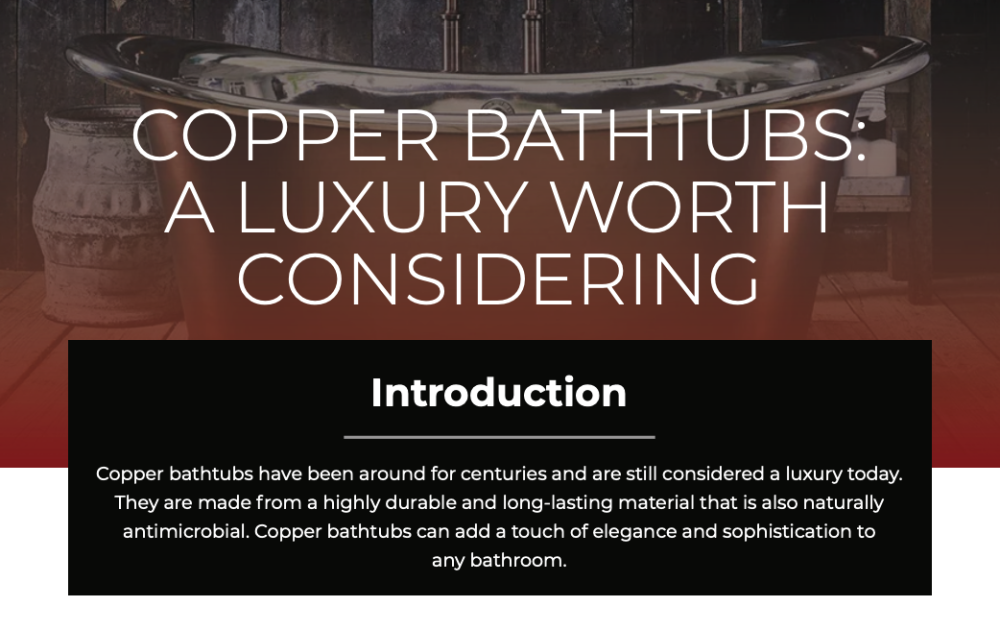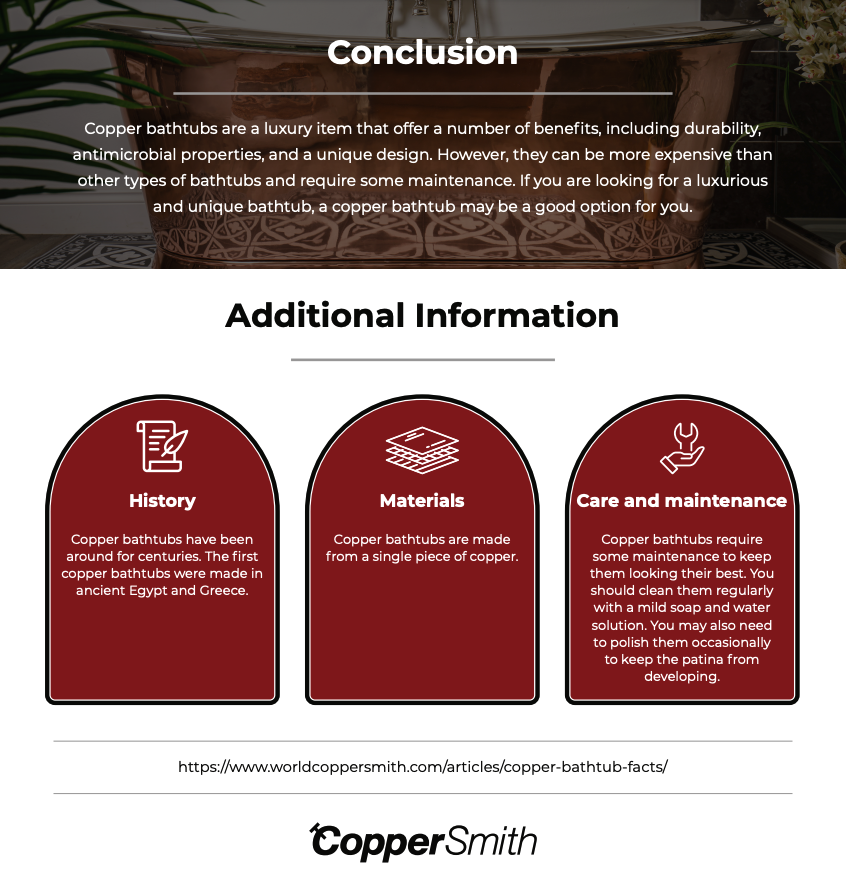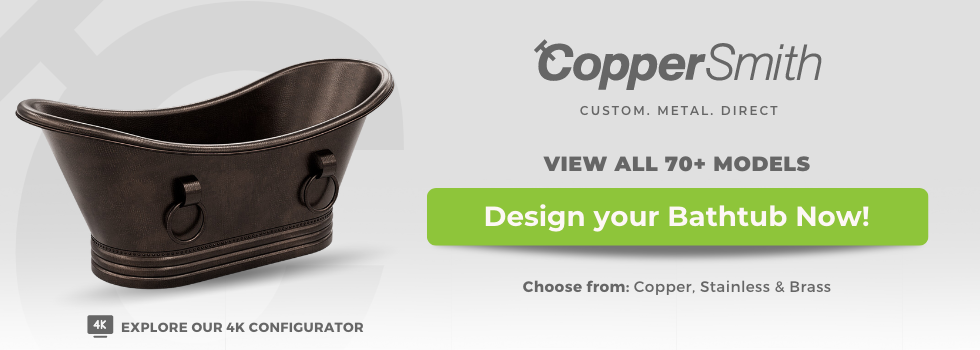
When thinking about bathroom designs, copper may not be the first material that comes to mind for a new bathtub. Many people opt for porcelain, ceramic, or acrylic tubs, but the benefits of copper bathtubs are quite convincing. If you’ve never considered buying a copper bathtub, here are some fascinating facts about copper that may change that.
Fun Facts About Copper
From its historical significance to its remarkable physical properties, copper continues to captivate people across the world with its unique qualities. Let’s explore some fun facts about copper.
Copper Is One of the Oldest Materials Used by Humans
Human beings have used copper for more than 10,000 years. One of the most versatile materials on the planet, copper has been used to create everything from hunting weapons and cooking equipment to decorative jewelry and electrical wiring. Its long-standing use is a testament to its durability and the crucial role it has played in human history.
Copper Is Known as the Eternal Metal
Copper is known as the eternal metal because it is 100% recyclable. If you’re shopping for a copper bathtub, you can choose between a pure copper tub or a recycled copper bathtub to promote sustainability. At CopperSmith, we offer a stunning collection of copper bathtubs made using recycled materials.
Copper Is Essential for Good Health
Copper isn’t just a strong, versatile, and beautiful material for building and designing products and structures. It is also essential for optimum human health. The body needs copper to generate energy, maintain a healthy immune system, and boost brain development. Foods that are rich in copper include liver, nuts, seeds, chocolate, mushrooms, and chickpeas.
Oxidized Copper Turns Green Over Time
One of copper’s most unique traits is its tendency to oxidize and turn green when exposed to the elements. A famous example is the Statue of Liberty, which has developed its green patina over time due to copper's natural oxidation process. This greenish hue is not only a natural occurrence but also helps protect the copper from further corrosion.
Important Copper Bathtub Facts
As fascinating as general copper facts may be, they don’t provide much insight when it comes to selecting the best material for bathtubs and other bathroom features. To truly understand why copper is an excellent choice, it’s important to look at the specific benefits it offers in the context of bathtub design and functionality.
Copper Has Natural Antimicrobial Properties
Copper is a fantastic choice for bathtubs as well as kitchen and bathroom sinks because it boasts natural antimicrobial properties. Copper has charged ions, which destroy viruses and harmful bacteria, creating safer and more hygienic environments. This makes copper particularly valuable in high-moisture areas such as bathrooms, where hygiene is crucial.
Copper Is Naturally Resistant To Rust and Corrosion
Unlike some other materials, copper doesn’t rust. Over time, it develops a unique patina that protects the metal and gives each bathtub a one-of-a-kind look. This natural resistance to corrosion means your tub can last for decades with proper care. The patina also acts as a protective layer, preventing further damage and ensuring your bathtub maintains its integrity over time.
Copper Retains Heat Exceptionally Well
One of the most-loved features of a copper bathtub is how well it holds heat. Because copper is a highly conductive metal, your bathwater stays warm for longer, perfect for long soaks and spa-like relaxation. This thermal efficiency allows you to enjoy a luxurious bath without constantly needing to add hot water.
Each Copper Bathtub Is a Work of Art
Because copper is malleable, artisans can handcraft tubs into a wide variety of shapes and styles. From sleek and modern to vintage style bathtubs, each offers timeless beauty and handcrafted detail you won’t find with mass-produced acrylic or porcelain tubs. This craftsmanship ensures that every copper bathtub is a unique piece, adding a touch of luxury and sophistication to any bathroom design.
Copper Bathtubs Are Environmentally Friendly
Copper is a 100% recyclable material, which makes copper bathtubs an eco-friendly option. Choosing a copper tub not only contributes to sustainability but also ensures you’re investing in a product that can be recycled at the end of its life. By opting for copper, you’re helping reduce the demand for disposable materials and supporting a circular economy.
How These Facts About Copper Make It the Perfect Material for Bathtubs
Copper bathtubs have a rich history and are known for more than just their striking beauty. They excel in areas such as sanitation and heat retention, where more traditional bathtub materials can fall short. Moreover, copper’s durability guarantees that your bathtub will stand the test of time, unlike other materials that may chip, crack, or lose their luster over time.
Beyond their functional advantages, copper bathtubs are visually captivating. The rich, warm tones of copper create an elegant focal point in any bathroom. Over time, the unique patina that develops adds character and individuality, making each copper tub a one-of-a-kind piece.
At World CopperSmith, we offer a wide range of high-quality custom bathtubs crafted from copper, brass, or stainless steel materials. Every bathtub model has numerous customization options to match any bathroom aesthetic. Whether you’re designing a sleek, modern space or a cozy, rustic retreat, we can help you find the perfect tub to complement your style.
Now that you know these facts about copper, are you ready to elevate your bathroom with a custom copper bathtub? Contact us today to learn more about our copper bathtubs and customization options.


